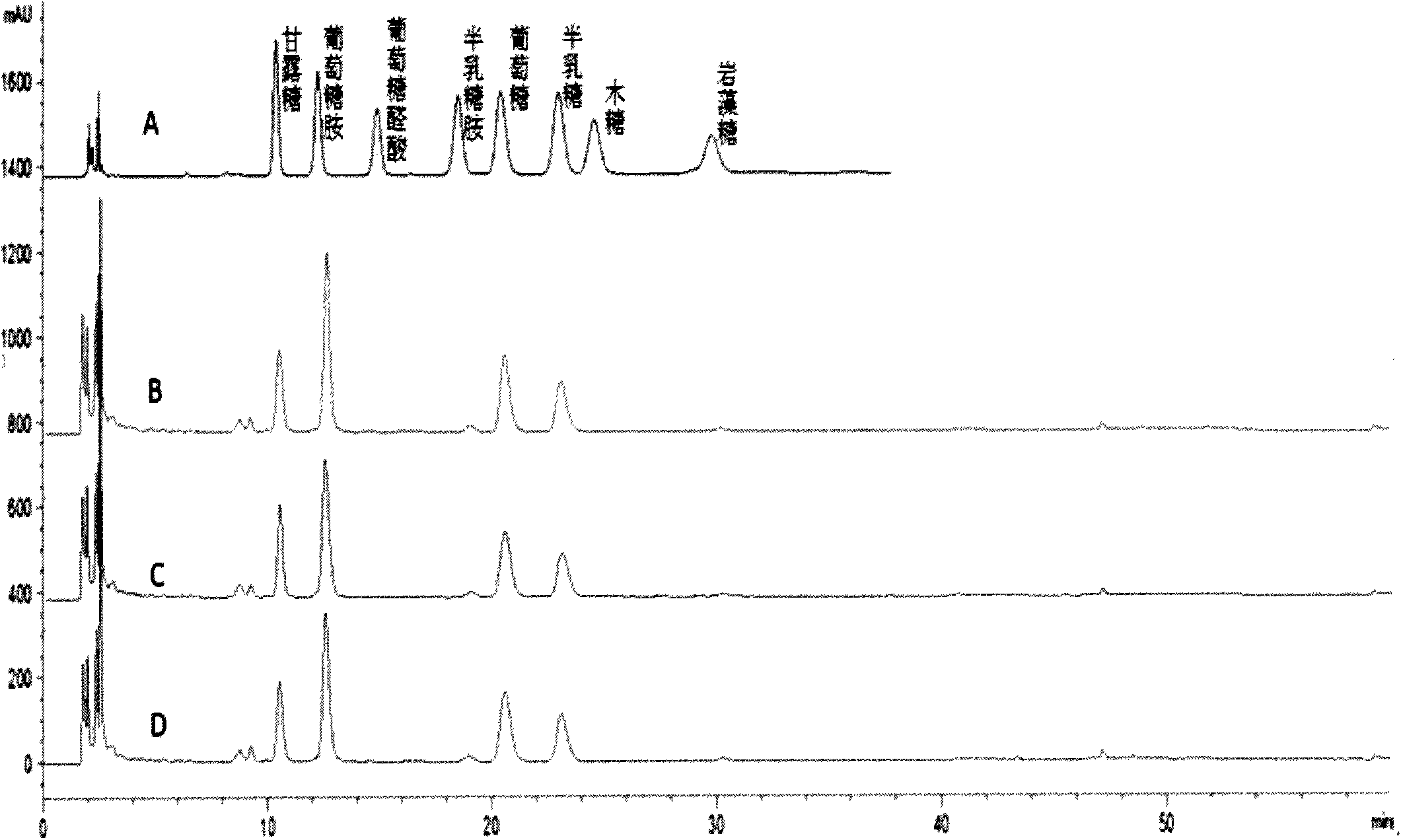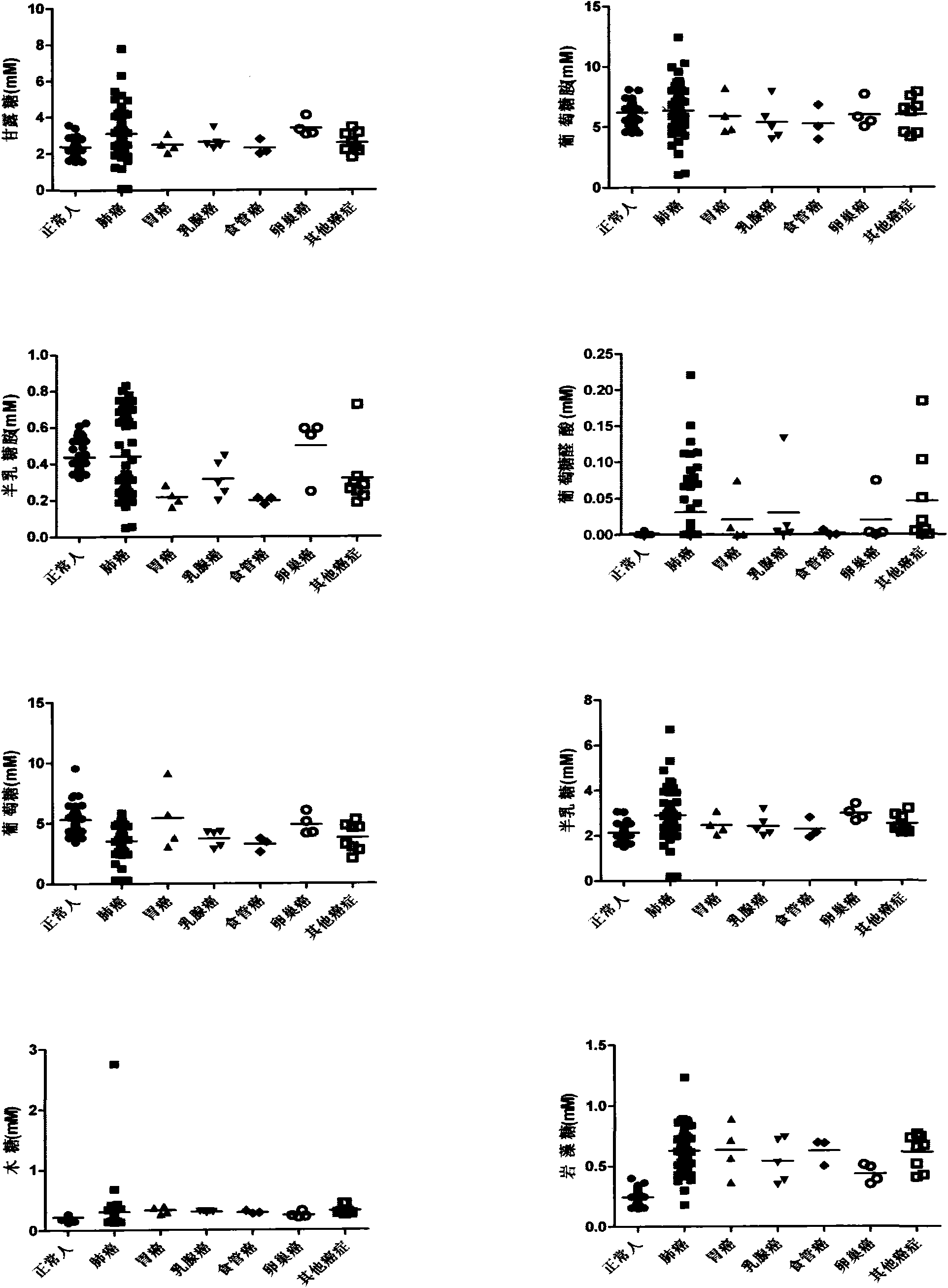Application of method for degrading blood to obtain monosaccharide and detecting monosaccharide in cancer detection
A cancer detection and monosaccharide technology, applied in the field of medicine, can solve the problems of low sensitivity of early cancer patients, difficulty in blood biomarkers, and large amount of data processing, etc., and achieve the effect of easy popularization of the method, short detection time and low detection cost
- Summary
- Abstract
- Description
- Claims
- Application Information
AI Technical Summary
Problems solved by technology
Method used
Image
Examples
Embodiment 1
[0032] (1) Prepare solutions with different concentrations (0.5mg / mL, 0.25mg / mL, 0.1mg / mL, 0.05mg / mL, 0.025mg / mL, 0.01mg / mL) containing 8 kinds of monosaccharide standards, and then add NH 3 ·H 2 O to adjust the pH to 8-14, mix well and let stand at room temperature, then add 0.5M PMP to the water bath.
[0033] (2) Take out the reactant and cool to room temperature, add HAc to neutralize.
[0034] (3) Add chloroform to each tube for extraction, discard the lower chloroform layer, and repeat three times. The obtained water layer was passed through a 0.22um filter membrane for liquid phase analysis.
[0035] Chromatographic conditions
[0036] Chromatographic column: ZORBAX SB-C18 (5um, 4.6mm×150mm), 0.1M phosphate (13.6gKH 2 PO 4 , 1.8gNaOH) (pH6.7) buffer-acetonitrile (volume ratio 83:17) isocratic elution, flow rate: 1.0mL / min, detection wavelength: 245nm, injection volume: 20uL.
[0037] To obtain the liquid chromatograms of 8 kinds of monosaccharide standards, see ...
Embodiment 2
[0040] (1) Take 1 mL of blood from 42 normal people and centrifuge at 3000 r / min for 5 min to separate serum or plasma.
[0041] (2) Take 100uL of plasma to the ampoule, add 1mL of 2M C to each tube 2 HF 3 o 2 .
[0042] (3) Seal the tube and put it in an oil bath at 105°C for 6 hours to obtain a hydrolyzed sample solution.
[0043] (4) Cool the hydrolyzed sample solution to room temperature, transfer to a 1.5mL centrifuge tube, and condense at -4°C for 5h to remove C 2 HF 3 o 2 .
[0044] (5) Add 100uL methanol to each tube, centrifuge and concentrate to remove residual C 2 HF 3 o 2 ,repeat three times.
[0045] (6) Each tube of the obtained dry sample is dissolved in water, and then NH 3 ·H 2O adjust the pH to 8-14, mix well and let stand at room temperature, then add 0.5MPMP to the water bath.
[0046] (7) Take out the reactant and cool to room temperature, add HAc to neutralize.
[0047] (8) Add CHCl to each tube 3 After extraction, the lower layer of CHCl w...
Embodiment 3
[0052] Get 52 routine lung cancer patient blood 1mL, all the other steps are the same as embodiment 2, embodiment 3 repeats 3 times, statistical detection result, see figure 2 .
PUM
 Login to View More
Login to View More Abstract
Description
Claims
Application Information
 Login to View More
Login to View More - R&D
- Intellectual Property
- Life Sciences
- Materials
- Tech Scout
- Unparalleled Data Quality
- Higher Quality Content
- 60% Fewer Hallucinations
Browse by: Latest US Patents, China's latest patents, Technical Efficacy Thesaurus, Application Domain, Technology Topic, Popular Technical Reports.
© 2025 PatSnap. All rights reserved.Legal|Privacy policy|Modern Slavery Act Transparency Statement|Sitemap|About US| Contact US: help@patsnap.com


